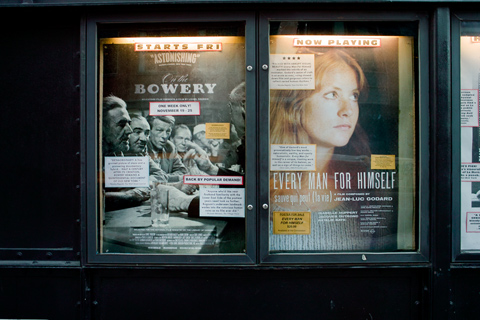
Film Forum, Houston Street — © Brian Rose
On Wednesday I walked over to Film Forum on West Houston to see On the Bowery, a movie I had heard about over the years, but never seen. It was recently re-released in a newly restored print. On the Bowery was made by Lionel Rogosin in 1957, and depicts three days of life on what was at that time America’s most infamous skid row. It is a hybrid film–part documentary, part directed narrative–and its characters were played by actual denizens of the Bowery, people that Rogosin had met over several month’s research before the movie was shot.
It remains, 53 years after its making, a cinematic tour de force. Rogosin worked with an extraordinary team, especially the cameraman Dick Bagley, and the editor Carl Lerner, who also worked on classic Hollywood movies such as 12 Angry Men. The story is minimal–a young man arrives on the Bowery with nothing but a suitcase and a powerful thirst for alcohol. He meets several regulars at a bar, ends up sleeping on the street, gets robbed, and is helped by his thief, a sly but sympathetic Bowery old-timer, who gives him some of the money he got from selling the newcomer’s stolen pocket watch.

The Bowery between Houston and Prince — still from On the Bowery
Most of the film was shot on the block between Houston and Prince Streets, and the Confidence Bar and Grill (above) once stood at the point where Stanton Street meets the Bowery. This is my corner of the world–my office/apartment is on Stanton just off the Bowery. When I first arrived in New York in 1977, I lived on East 4th Street five blocks north. The Bowery was still skid row in those days, and remained a seedy final destination for untold thousands until well into the 1990s. It is skid row no longer as high end restaurants and galleries supplant the cheap hotels and restaurant supply stores that dominated the area, some of which of can be seen in the film.
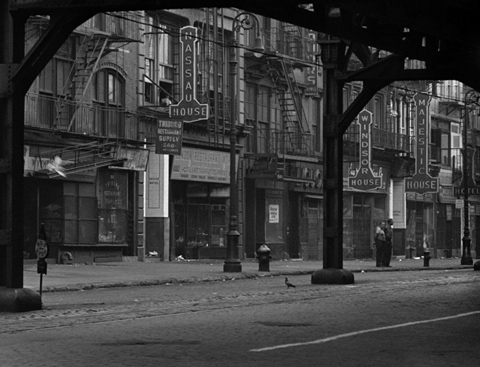
The Bowery between Houston and Prince — still from On the Bowery
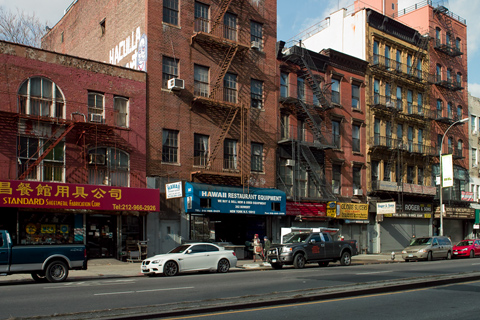
The Bowery between Houston and Prince — similar view as above
— © Brian Rose
For nearly 75 years the Bowery was darkened by the elevated tracks running its length and on up Third Avenue into the Bronx. But by 1957 the steel viaduct was no longer used and was in the process of being demolished. In Rogosin’s film the hulking structure of the El lends many of the scenes a closed off subterranean feel. The stretch of Bowery buildings shown above still stands, almost as ragged looking as before, but without the encompassing gloom and claustrophobia.
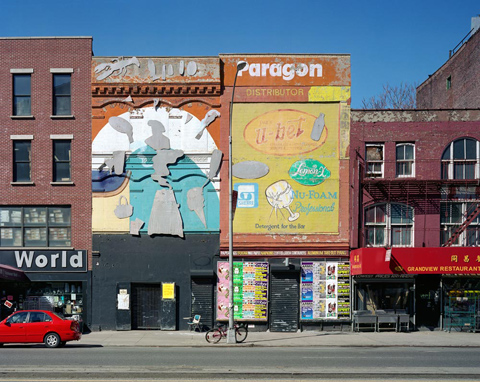
The Bowery between Houston and Prince (4×5 film) — © Brian Rose
A few years ago I took the picture above with my view camera. The building at left with the cutouts attached to the facade is 254 Bowery, the former location of the Confidence Bar and Grill. In the movie still you can see the word Paragon on the building next door. That’s the same building above from around 2005.
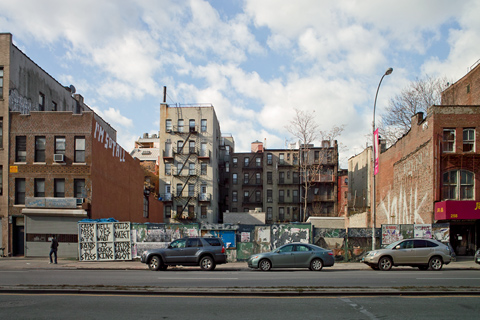
The Bowery between Houston and Prince — © Brian Rose
But those buildings are gone now. The site was cleared for the construction of a luxury hotel, a project that died when the economy collapsed in 2008. The lot has sat vacant since then, but I read recently on Curbed, the architecture and real estate blog, that a new project may be in the works.
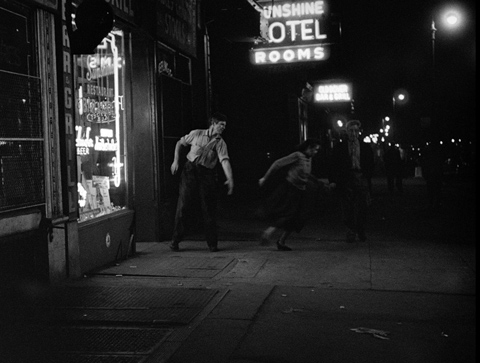
The Sunshine Hotel, Bowery and Stanton Street — still from On the Bowery
Near the end of On the Bowery, the lead character, Ray Salyer, goes to the Bowery Mission with hopes of staying sober, but after being preached to and finding he has to sleep on newspapers spread on the floor, he heads back out to the street. In a stunning montage, as he drinks himself into a stupor, he and the other men get louder and louder, epithets are hurled, fisticuffs break out–however ineffectual–and the scene unwinds in a chaotic drunken din. Salyer, with a woman on his arm, stumbles from the bar and heads for the Sunshine Hotel, where he slaps her away (seen above). The Sunshine is one of the last Bowery flophouses, right next door to the New Museum, still home to a dwindling assortment of derelict men, a no vacancy sign on the door, the end in sight.
The film closes with another montage, as astonishing as the barroom scene. As Salyer stands on the Bowery contemplating his next move, a sequence of closeups of faces is shown, each held on the screen a few seconds. Each visage a portrait of utter dissolution, each line and crease, stubble of beard and trickle of dried blood, rendered vividly, dispassionately.
There is no redemption suggested in this ending, and even though On the Bowery was hailed by many, and nominated for an Oscar, its bleak outlook was not generally welcome in the propagandistic 1950s. Rogosin’s On the Bowery shares the unsparing outlook of Robert Frank who also revealed the underside of American society in his book The Americans. Frank’s documentary approach has been widely absorbed by several generations of photographers, but Rogosin’s method, combining documentary and staged reality, remains under appreciated by those of us schooled in the cinema verite style.
Seeing the movie, and then walking back to my office right where the film was made, a neighborhood already changed, undergoing even more radical transformation–it’s quite a lot to reflect on.
Wow! Hope I can get my mitts on this one here in SF! I remember drinking at… The Half Moon Tavern. Everyone (and I do mean every single person- at the bar, and surrounding tables) had a quart of Bud in hand.